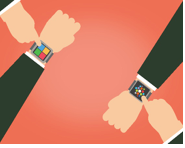FDA Releases New Digital Health Draft Guidance Documents
In this interview, Austin Speier, VP of Emerging Technologies at Precision for Medicine, will elaborate on these draft guidance documents.
In line with its promises to offer more guidance on Digital Health in the Digital Health Innovation Action Plan, FDA recently released several draft guidance documents including Changes to Existing Medical Software Policies Resulting from Section 3060 21st-Century Cures Act, and Clinical and Patient Decision Support Software. In this interview, Austin Speier, VP of Emerging Technologies at Precision for Medicine, will elaborate on these draft guidance documents.
Moe Alsumidaie: How do the changes made in the updated 21st Century Cures Act draft guidance document apply to digital health?
Austin Speier

Austin Speier: The 21st Century Cures Act (Cures Act) signed into law in December 2016 included key provisions that defined which software products are exempt from regulation by FDA. The recent 21st Century Cures Act Guidance issued by FDA stays very close to the original language of the Cures Act, in fact quoting it verbatim. Essentially, the Cures Act modified the definition of what constitutes a ‘medical device’ (as defined in the Food, Drug & Cosmetic Act), by excluding specific categories of software by law from the medical device definition. As such, in this Guidance, FDA is primarily restating what Congress established as limitations to the definition of medical device, and is not providing much interpretation beyond that given in the Cures Act. Because of these changes, FDA indicates that it will remove all references to the now-excluded categories of software from its existing policies and Guidance. FDA then describes how historical device classifications and policies will be modified because of the Cures Act.
In addition, FDA indicates that from now on it will discuss in its policy and Guidance whether ‘software functions’ are regulated, rather than ‘apps’ or ‘software’, which is a minor shift in terminology. This new terminology allows FDA more flexibility in deciding how to regulate complex products that may contain multiple software functions. FDA intends to release a draft Guidance on the regulation of products with multiple functions-including products containing both regulated and unregulated functions-in 2018.
MA: Can you describe the CDS draft guidance, and provide an example of a CDS product that falls under this draft guidance’s proposed regulation? Does Artificial Intelligence also fall under the CDS draft guidance?
AS: Clinical Decision Support (CDS) software is a rapidly growing, broad category of software tools intended to facilitate health care interactions by supporting the speed, consistency, and quality of decisions made by clinicians. Many of these CDS products exist at the intersection of healthcare IT (such as electronic medical records), which is historically not regulated by FDA, and software-based medical devices, which are regulated by FDA. As a result, many CDS products exist in a regulatory ‘gray area’ and so the industry has been looking for Guidance from FDA for more clarity as to how the Agency will regulate CDS. This Guidance has been in the works for over 6 years. The passage of the 21st Century Cures Act in December 2016 finally triggered its release by laying out a basis in law for what constitutes regulated CDS and unregulated CDS. The recent CDS Guidance from FDA outlines FDA’s interpretation of the CDS provisions of the Cures Act to create a framework for regulation of CDS.
For FDA purposes, CDS software is defined as software that meets the following 3 criteria: (1) it is “not intended to acquire, process, or analyze a medical image or a signal from an in vitro diagnostic (IVD) device or a pattern or signal from a signal acquisition system”; (2) it is “intended for the purpose of displaying, analyzing, or printing medical information about a patient or other medical information (such as peer-reviewed clinical studies and clinical practice guidelines)”; and (3) it is “intended for the purpose of supporting or providing recommendations to a health care professional about prevention, diagnosis, or treatment of a disease or condition.”
Regarding (1), as soon as the software interfaces directly with traditional medical devices such as IVDs or “signal acquisition systems” (respiratory monitors, EEGs, medical imaging, etc.), FDA considers the software a medical device and not CDS. If a product meets criteria (1)-(3), and is therefore CDS, then it may or may not be FDA-regulated. A fourth criterion comes into play at that point: (4) the CDS is “intended for the purpose of enabling such health care professional to independently review the basis for such recommendations that such software presents so that it is not the intent that such health care professional rely primarily on any of such recommendations to make a clinical diagnosis or treatment decision regarding an individual patient.” If the CDS meets criterion (4), then it is FDA-exempt. The key concept in criterion (4) is that the software must allow the clinician to “independently review the basis for [its] recommendations.” FDA then describes how CDS can meet this criterion. Essentially, the CDS must be able to describe and support the rationale for any recommendations it issues, such that the clinician could independently arrive at the same conclusion on his/her own, using publicly available information (e.g., treatment guidelines or published literature). In other words, as soon as the CDS is providing any interpretation that is not independently reproducible, then it is subject to FDA regulation.

In the case of Artificial Intelligence, CDS products that rely on, for example, machine learning, could remain FDA exempt, so long as the machine learning algorithm was used prior to the release of the CDS, and the machine learning process, results, and scientific rationale are published in the literature. In this case, if the clinician were to question the CDS recommendation, he/she could review the process used by the CDS’s underlying AI algorithm to arrive at its recommendation independently. However, if the AI is generating recommendations in any way that is not transparent or reproducible by the clinician (for example, if the AI is continuing to learn/adapt using a growing, unpublished dataset), then the AI-based CDS software would be subject to FDA regulation.
MA: What types of companies will release CDS products? Do you believe the push will be coming from technology, medical device, or biopharmaceutical enterprises? Where are the opportunities for market growth?
AS: There is an increasing demand for CDS products, primarily driven by the need of hospitals, health systems and accountable care organizations (ACOs) to increase both clinician efficiency and quality of care. Further, CDS will be critical for physicians to handle the mounting scientific complexity and massive amounts of data being generated by precision medicine, advanced -omics, and digital health. CDS can support clinician efficiency by, for example, automating the process of reviewing the literature to identify the latest therapeutic options for a patient, customized based on the specific patient’s demographics and test results. CDS can also ensure that the latest clinical guidelines applicable to a specific patient are automatically called up during patient visits, to ensure consistency of care across an organization. These tools are essential to bringing about a cost-efficient, high quality health system. There is some concern that the framework proposed by FDA may be too stringent to support CDS innovation, and will result in a delay in access to some of these tools. On the other hand, FDA oversight may ensure a certain level of quality as clinicians increasingly learn to rely on these tools.
MA: What validation processes does the FDA propose to approve CDS software?
AS: The CDS Guidance sets forth criteria for whether a given CDS software function would be regulated by FDA. If the product is FDA-regulated, then the traditional FDA regulatory framework for medical devices applies. That is, the regulatory pathway (e.g., 510(k), De Novo or PMA filing) and the associated evidence requirements (analytical and clinical validation), would depend on the intended use, technological characteristics, and risk classification (Class I, II, or III) of the CDS. If there is any uncertainty as to how the CDS should be regulated (for example, due to lack of similar precedent products) then it is recommended to develop a regulatory and evidence development strategy for the CDS that can then be presented to FDA for feedback via the Pre-Submission process.
Moe Alsumidaie, MBA, MSF is Chief Data Scientist at Annex Clinical, and Editorial Advisory Board member for and regular contributor to Applied Clinical Trials.
FDA Fast Tracks Johnson & Johnson’s Nipocalimab for Fetal Neonatal Alloimmune Thrombocytopenia
March 27th 2024Johnson & Johnson is moving forward with a pair of Phase III trials of nipocalimab to reduce the risk of fetal neonatal alloimmune thrombocytopenia in alloimmunized pregnant patients.